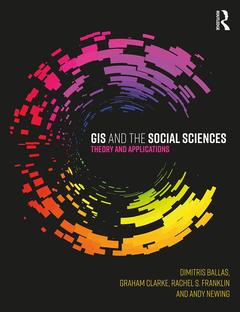GIS and the Social Sciences Theory and Applications
Auteurs : Ballas Dimitris, Clarke Graham, Franklin Rachel, Newing Andy

GIS and the Social Sciences offers a uniquely social science approach on the theory and application of GIS with a range of modern examples. It explores how human geography can engage with a variety of important policy issues through linking together GIS and spatial analysis, and demonstrates the importance of applied GIS and spatial analysis for solving real-world problems in both the public and private sector.
The book introduces basic theoretical material from a social science perspective and discusses how data are handled in GIS, what the standard commands within GIS packages are, and what they can offer in terms of spatial analysis. It covers the range of applications for which GIS has been primarily used in the social sciences, offering a global perspective of examples at a range of spatial scales. The book explores the use of GIS in crime, health, education, retail location, urban planning, transport, geodemographics, emergency planning and poverty/income inequalities. It is supplemented with practical activities and datasets that are linked to the content of each chapter and provided on an eResource page. The examples are written using ArcMap to show how the user can access data and put the theory in the textbook to applied use using proprietary GIS software.
This book serves as a useful guide to a social science approach to GIS techniques and applications. It provides a range of modern applications of GIS with associated practicals to work through, and demonstrates how researcher and policy makers alike can use GIS to plan services more effectively. It will prove to be of great interest to geographers, as well as the broader social sciences, such as sociology, crime science, health, business and marketing.
Preface
Chapter 1: An introduction to GIS
Chapter 2: Spatial analysis in GIS
Chapter 3: Thematic Mapping, GIS and Geovisualisation
Chapter 4: GIS and Network Analysis
Chapter 5: GIS and the classification of people and areas (indexes of deprivation and Geodemographics)
Chapter 6: GIS and small area estimation of income, well-being and happiness
Chapter 7: GIS and Crime Pattern Analysis
Chapter 8: GIS and Health Care Planning and Analysis
Chapter 9: GIS for Retail Network Planning and Analysis
Chapter 10: GIS for Emergency Planning
Chapter 11: GIS and Education planning
Chapter 12: GIS and Transport analysis and planning
Chapter 13: GIS for Environmental Justice and Policy Evaluation
Dimitris Ballas is Professor of Economic Geography at the University of Groningen, the Netherlands. He has published widely in the fields of Social and Economic Geography, Regional Science and Geoinformatics in the Social Sciences. His recent books include The Human Atlas of Europe: A Continent United in Diversity (co-authored with Danny Dorling and Benjamin Hennig).
Graham Clarke is Professor of Business Geography at the University of Leeds, UK. He specialises in the application of GIS for service analysis and planning, particularly within the context of health and retailing.
Rachel S. Franklin is Associate Director of the Spatial Structures in the Social Sciences (S4) initiative and Associate Professor (Research) of Population Studies at Brown University, USA.
Andy Newing is a Lecturer in Retail Geography at the School of Geography, University of Leeds, UK. Andy contributes extensively to undergraduate and master’s level GIS teaching and student supervision within the social sciences.
Date de parution : 10-2017
18.9x24.6 cm
Date de parution : 09-2017
18.9x24.6 cm
Thème de GIS and the Social Sciences :
Mots-clés :
Spatial Microsimulation; Geovisualisation; Lower Layer Super Output Areas; Thematic mapping; Smart Card Data; Crime Pattern Analysis; Small Area Microdata; index of deprivation; Spatial Microsimulation Models; Education planning; Data Set; Emergency planning; Geodemographic Classification; Geodemographics; Small Area Estimation; Graham Clarke; Location Allocation Model; Rachel S; Franklin; Dot Density Map; Andy Newing; Spatial Interaction Models; UK FES; Small Area Level; Block Group Centroids; Areal Interpolation; Digital Boundary Data; Thiessen Polygons; Proprietary GIS Package; Neighbourhood Centroids; Small Area Census Data; Average Income; LSOA Level; Microsimulation Models; National UK Average; Late Stage Colorectal Cancer



